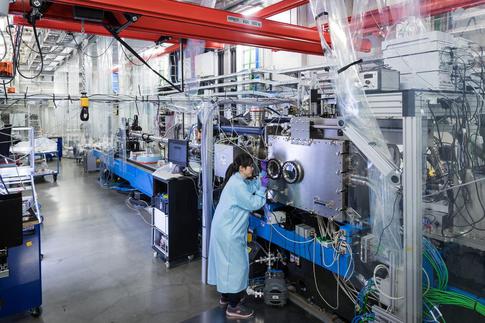XFEL: Getting the timing right for molecular movies
Getting the timing right for molecular movies
Scientists have long dreamed of being able to film the details of chemical and biological reactions by taking, and stitching together snapshots of these processes. Getting the timing of the individual shots of the movies just right is dependent on a number of factors including understanding the timing variation, or so-called ‘jitter’, of the laser beams used to take the images. In an experiment published now in the journal Optics Letters, scientists describe how they measured the jitter at the SPB/SFX instrument at European XFEL and demonstrate how this unavoidable and undesirable effect might be overcome. The knowledge gained from these movies could lead to new technological innovations and developments. 
The SPB/SFX instrument at European XFEL. Copyright European XFEL
Biological and chemical reactions happen extremely quickly and filming them requires an extremely fast and precise camera. Much like a fast exposure time can be used to capture a series of images showing details of the movements a sprinter makes during a race, so the extremely short bursts of X-rays produced by facilities such as European XFEL are short and frequent enough to capture the sequence of molecular movements that happen during a reaction. To make a molecular movie, scientists can, for example, first kick-start the reaction they want to film by hitting their sample of choice with a laser. Then, the intense X-ray laser is used to take a sequence of images of the molecular process as it unfolds. Getting the timing of the two lasers just right is crucial for the success of these types of experiments, however, at these speeds, it is not trivial.
The bursts, or pulses, of X-ray light generated by European XFEL are each less than a few millionths of a billionth of a second, or a few femtoseconds. As a comparison, a blink of an eye lasts about 300 milliseconds, or a third of a second. While these extremely short bursts of light produced by European XFEL make it now possible to capture the fast changes occurring during a reaction, even the slightest timing delay or variation in the experiment set-up can counteract the benefits of using the ultra-short X-ray pulses in the first place. Timing variation of the X-ray and laser set-up, known as ‘jitter’, can be caused by, for example, thermal expansion of electrical cables over the length of the 3.4 km long facility and slight changes in air pressure that can alter the optical path of the laser. Therefore, accurate measurement of the jitter is crucial for scientists to be able to take this into consideration when evaluating their work, and help keep the disturbance to a minimum.
Scientists at European XFEL have now measured the jitter at the SPB/SFX instrument. The results published in the journal Optics Letters show a jitter of 308 femtoseconds. The scientists expect to be able to reduce the jitter significantly as upgrades are made to the European XFEL timing system. Timing tools will also be supplied to users in the near future which can be used to overcome the timing jitter.
Scientists from European XFEL, Kiel University, Helmholtz-Zentrum Dresden-Rossendorf, La Trobe University, SLAC National Accelerator Laboratory, and DESY were involved in the publication.
Original Article:
Initial observations of the femtosecond timing jitter at the European XFEL
H. J. Kirkwood, R. Letrun, T. Tanikawa, J. Liu, M. Nakatsutsumi, M. Emons, T. Jezynski, G. Palmer, M. Lederer, R. Bean, J. Buck, S. Cafisio, R. Graceffa, J. Grünert, S. Göde, H. Höppner, Y. Kim, Z. Konopkova, G. Mills, M. Makita, A. Pelka, T. R. Preston, M. Sikorski, C. M. S. Takem, K. Giewekemeyer, M. Chollet, P. Vagovic, H. N. Chapman, A. P. Mancuso, and T. Sato
Optics Letters, 44, 1650 (2019)
